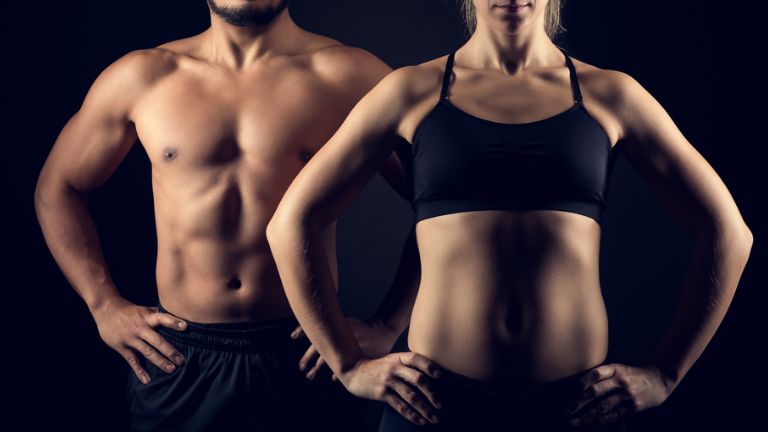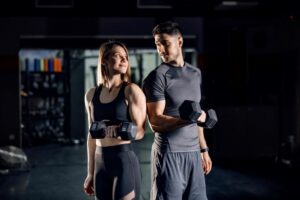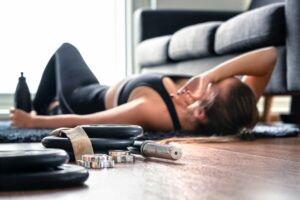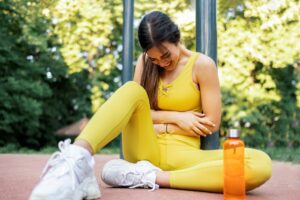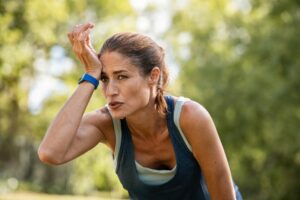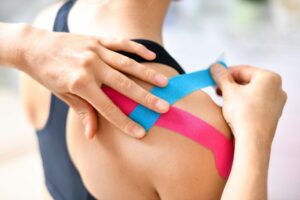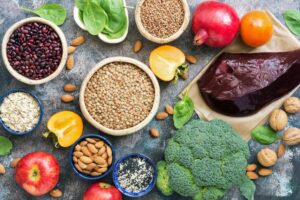Can gender affect performance results? Should training for women differ to men? And what about nutrition? Rob Hobson is here to explain all we need to know
If you are interested in keeping fit then it goes without saying, you want to achieve the goals you set yourself whether that is running faster, lifting heavier or shedding a few pounds.
To achieve this requires consistency and a well thought through diet and training plan, alongside other lifestyle factors.
There are differences between gender when looking at training for women vs training for men. But the information provided to help women achieve their performance goals, is often biased towards men and doesn’t consider the issues that are unique to their sex.
There are differences between gender when looking at training for women vs training for men
This is because, a significant amount of sports performance research is based on men. This is often because women are physiologically too variable, one reason being the menstrual cycle, the use of oral contraceptives or HRT.
But there are many differences that occur between sexes, and these include both physiology and psychology.
READ MORE: 9 Pilates benefits you probably didn’t know about
Reason #1 Women differ from men physiologically
Men and women are physiologically different, including muscle mass and strength, maximal aerobic capacity and performance, and anaerobic power and capacity.
Research shows that a female’s absolute whole-body strength is up to 63.5 per cent of a man’s, while upper body strength is 55 per cent and lower limb strength is 72 per cent.
Female-specific issues need to be considered
This means that advice on what exercises to perform and how much to lift and how to monitor your performance may not be relevant to women who shouldn’t be considered as ‘small men’ when delivering advice.
Reason #2 Female health issues may impact training and performance
Female-specific issues need to be considered, so that women can get the right advice to suit their performance goals and needs.
Such issues include the menstrual cycle, breast health, female psychology, and trends in female injuries.
Women are also more prone to nutrient insufficiencies such as iron, resulting in fatigue and depression, which can hamper their efforts to stick to a training plan.
READ MORE: Fad Diet FAQ’s with Instagram PT Courtney Black
Reason #3 Women are prone to RED-S
Women are prone to RED-S, which refers to Relative Energy Deficiency in Sport.
This used to be called the ‘Female Athlete Triad’ (disordered eating, menstrual disturbance, low bone density), but was renamed to reflect that it also occurs in men and impacts more than the three original areas described initially.
The condition is when athletes do not have enough energy to meet the demands of the amount of exercise they perform.
Athletes more prone to RED-S include endurance athletes who benefit from a high power-to-weight ratio, weight category sports such as boxing, and aesthetic sports such as gymnastics and diving.
RED-S also impacts an athlete’s ability to maintain overall optimal health
Alongside insufficient energy to achieve peak sports performance, RED-S also impacts an athlete’s ability to maintain overall optimal health and other bodily functions.
This can result in irregular periods, recurrent illnesses, mood changes, delayed growth and development, and nutrient deficiencies.
While this is normally something referred to in athletes, the same can occur in women who are very fit recreationally and is something that should be addressed if they exhibit any symptoms.
READ MORE: A gynaecologist’s guide to PMS
Reason #4 The menstrual cycle impacts performance
Premenstrual syndrome (PMS) is a combination of mood, behavioural and physical changes experienced by some women between two to 14 days before menstruation (e.g. premenstrual phase).
Symptoms include tension, depressed mood, irritability, tearfulness, mood swings, and physical complaints, such as abdominal cramps, breast tenderness, and bloating.
Symptoms are often mild but can be severe enough to affect daily activities, and this includes a women’s ability to exercise.
40 per cent of female athletes feel that training and performance are impaired due to PMS
Studies report that PMS can cause athletes to feel ‘out of action’, ‘demotivated’ and ‘sluggish during training’.
Although not directly assessed in terms of the effects of PMS on exercise performance per se, studies report that around 40 per cent of female athletes feel that training and performance are impaired due to premenstrual symptoms.
Advice around the best way to tackle PMS is useful and women may want to consider planning their training days around their menstrual cycle to maintain motivation and the ability to train at the best.
Dietary advice for athletes suffering from PMS:
- Reduce intake of refined sugar, salt, red meat, and alcohol.
- Eat oily fish, poultry, and green leafy vegetables.
- Reduce intake of coffee, tea, chocolate, and cola drinks.
- Reduce intake of unhealthy fats found in processed foods.
- Increase intake of fibre in the form of green leafy vegetables and fruits.
- Consider supplements such as evening primrose oil and vitamin B6 (50-100mg daily) , which may assist with alleviating PMS.
Reason #5 The menopause also impacts performance
Most notably, discussions around this topic are focused on endurance sports and women over 40 who are referred to as masters class.
This is one of the fastest growing categories in endurance events, such as marathons and triathlons which have become more popular over the years. There are more considerations for women as they age and one is the impact of menopause.
Marked hormonal changes are seen during menopause, most notably, the decline in oestrogen levels. Women are at an advantage in endurance sports due to the way the utilise energy sources in the body.
loss of oestrogen during menopause is linked with unfavourable changes in energy metabolism
It has been shown that women have enhanced fat oxidation, which means they are able to save carbohydrate stores in the body, influenced by oestrogen. Hormonal changes during menopause can have an unfavourable effect on female athletes.
‘The loss of oestrogen during menopause is linked with unfavourable changes in energy metabolism, including increases in body fat and decreases in exercise capacity,’ explains Dr. Emma O’Donnell, Senior Lecturer in Exercise Physiology.
‘Such effects are associated in part with decreased endurance performance in oestrogen deficient perimenopausal and post-menopausal women compared with oestrogen replete pre-menopausal women’.
Reason #6 Women are prone to injury
Interestingly women are more prone to certain injuries than men. It has been shown that women experience more stress fractures, shoulder injuries, ankle sprains, and ACL injuries than men.
Some women are at higher risk of low bone mineral density which can increase the risk of musculoskeletal injury. This is particularly relevant to women who may have experienced issues around disordered eating in their teens or early twenties when their bones where still growing and older women in menopause.
Research has also shown that women are at greater risk of overuse injuries
Ligamentous laxity (very flexible joints) is more significant in women, explaining why they experience ankle sprains twice as often as men.
Research has also shown that women are at greater risk of overuse injuries, including stress fractures, tendonitis, and medial tibial stress syndrome (damage to the shin area).
What’s more, it has been shown that female athletes in jumping and cutting sports (football, basketball, lacrosse) are up to six times more likely to sustain a severe knee injury than males.
Understanding this means women can make more informed choices about the type of kit they chose to wear and make them more aware of their risk when exercising.
READ MORE: Embracing Veganuary? Nutritionist reveals 5 things to consider if you are
Reason #7 Women have specific nutritional needs
The basic principles of healthy eating apply to everyone. Historically gender-specific nutrition guidelines have been lacking.
Iron is a crucial consideration for women
However, a recent review published in the Journal of the International Society of Sports Nutrition offered some guidance to female athletes regarding food and supplements.
This includes…
Maintaining a good intake of iron
Iron is a crucial consideration for women and research has shown that 27 per cent lack this mineral in their diet. Low intakes put women at greater risk of anaemia which can cause extreme fatigue.
Women at greater risk include:
- Those following restrictive diets such as veganism.
- Those involved in sports with high amounts of repetitive ground strikes, such as long-distance running.
- Those heavily involved in endurance sports – training can cause antioxidant depletion and red blood cell damage.
- Women with heavy menstrual bleeding.
The UK RDA for iron in women is 14.8mg. Interestingly, it has been suggested that female athletes consume 18mg per day.
Vegan athletes should partner their iron-rich foods (beans, lentils, pulses, dark green leafy vegetables, nuts, and seeds) with foods rich in vitamin C to help with absorption.
READ MORE: 5 reasons a high protein diet is key for fat loss
Maintaining a good intake of calcium and vitamin D
Calcium and vitamin D are also important and work in synergy to support bone health. Women should include three to four servings of calcium-rich foods in their diet daily to achieve an intake of 1000mg daily.
Supplementing with vitamin D is essential during the winter months as you cannot get what you need from diet alone.
Try: Healthspan Super Strength Vitamin D – £3.95. Or for those doing performance sport there is the Elite range which is 100ug, 4,000iu and Informed Sport-batch tested.
Consider the effect of the menstrual cycle on protein intake
Protein is vital for women engaged in regular exercise especially weight bearing. The best way to consume protein is after training and then regularly across the day.
aim for around 1 to 1.2g protein per kg body weight
Women who exercise regularly and include weight bearing exercise into their regime should probably aim for around 1 to 1.2g protein per kg body weight.
Research involving female athletes suggests that during the follicular phase of the menstrual cycle, they increase their intake of protein to at least 1.6g per kg body weight2, as the demand for protein increases.
It has also been suggested that protein intakes may be higher during the luteal phase as increased progesterone leads to higher rates of protein breakdown.
Women are not only physiologically different from men but have specific health needs unique to their gender. More research is needed to fully understand the impact female health has on performance.
Still, what is known should be used to inform women on the best way to train to suit the needs and demands of their body.
Rob Hobson is the Head of Nutrition at Healthspan Elite, a sports supplement brand who also co-created a range for the All Blacks and work with leading sports bodies such as British Cycling, British Athletics to name a few.
Rob also sees private clients who are looking to support their diet whether that be for performance or just everyday ways to support their nutrition.
Like this article? Sign up to our newsletter to get more articles like this delivered straight to your inbox.



